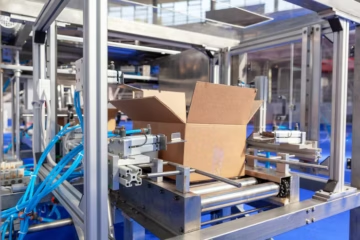A grooving machine is a key piece of equipment in the paper box manufacturing industry, playing a vital role in creating the necessary grooves and cutouts on cardboard or paperboard to facilitate the assembly of paper boxes. Understanding its working principle is essential for appreciating its importance in the production process.
The fundamental components of a grooving machine include the cutting unit, the feeding mechanism, and the control system. The cutting unit is the heart of the machine, responsible for making the actual cuts and grooves on the material. It typically consists of one or more rotating blades or knives, which are made of high-quality materials such as tungsten carbide or high-speed steel to ensure durability and sharpness. These blades are mounted on a shaft and are driven by a powerful motor, which rotates them at high speeds.
The feeding mechanism is designed to transport the cardboard or paperboard through the machine in a controlled manner. It can be either manual or automatic, depending on the type and complexity of the grooving machine. In an automatic feeding system, sensors are used to detect the position and movement of the material. The material is then precisely positioned and fed into the cutting unit at a consistent speed. This ensures that the cuts and grooves are made accurately and evenly across the entire surface of the material.

The control system of the grooving machine is what enables the operator to set and adjust various parameters to achieve the desired cutting results. These parameters may include the depth of the grooves, the width of the cuts, the spacing between the grooves, and the speed of the cutting process. The control system can be a simple mechanical system in older models or a sophisticated computerized system in modern machines. In computerized systems, the operator can input the required parameters through a user interface, and the machine will automatically adjust the cutting unit and the feeding mechanism accordingly.
When the machine is in operation, the cardboard or paperboard is first fed into the machine by the feeding mechanism. As the material passes through the cutting unit, the rotating blades make contact with it and cut through the surface to create the grooves and cutouts. The depth of the cut is determined by the position of the blades, which can be adjusted using the control system. The width of the cut is determined by the size and shape of the blades.
After the cutting process is completed, the grooved material is discharged from the machine. Some grooving machines may also be equipped with additional features, such as a waste removal system to collect and remove the cardboard scraps generated during the cutting process, or a scoring mechanism to create creases for easier folding of the paper box.
In conclusion, the grooving machine works by using a combination of a high-speed rotating cutting unit, a precise feeding mechanism, and an intelligent control system to create accurate grooves and cutouts on cardboard or paperboard. This process is essential for the production of high-quality paper boxes, as it ensures that the boxes can be easily assembled and have a professional appearance.


